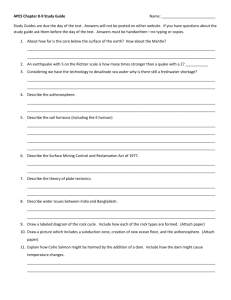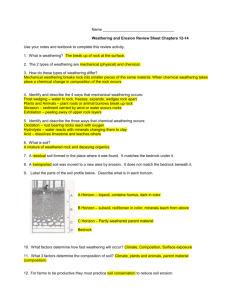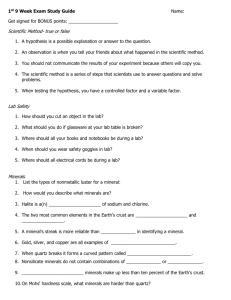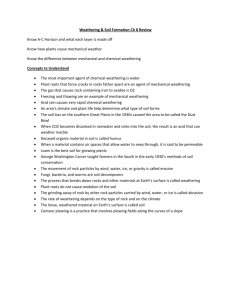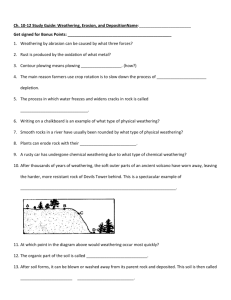Earth Science –Summer Quiz 2 Choose the best multiple choice
advertisement
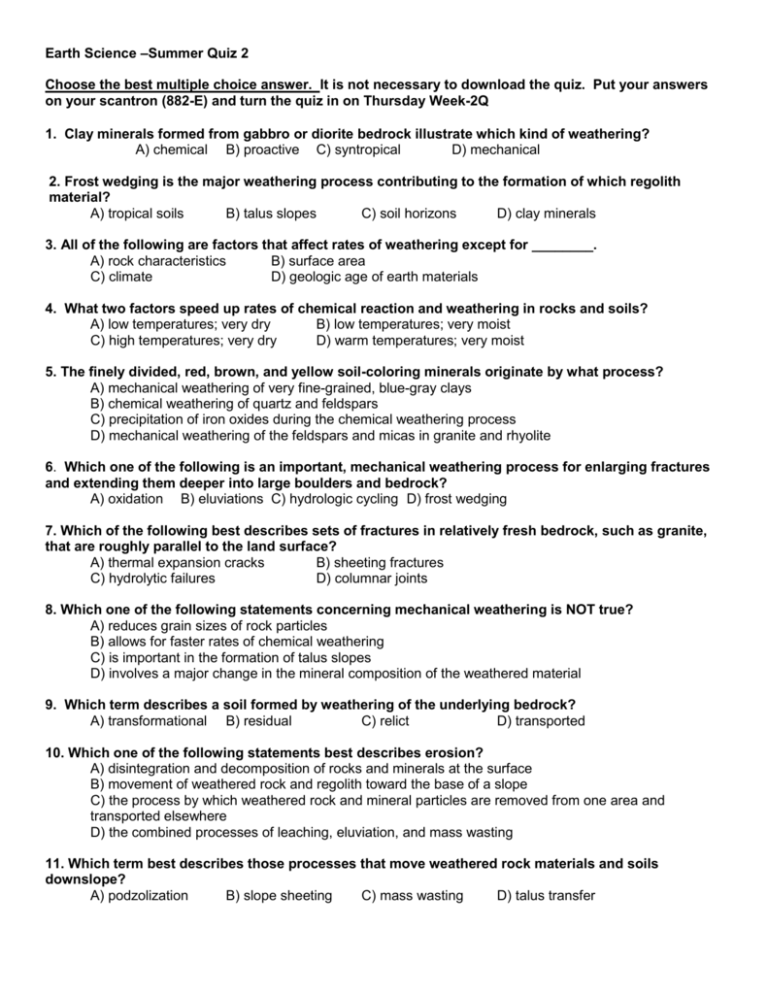
Earth Science –Summer Quiz 2 Choose the best multiple choice answer. It is not necessary to download the quiz. Put your answers on your scantron (882-E) and turn the quiz in on Thursday Week-2Q 1. Clay minerals formed from gabbro or diorite bedrock illustrate which kind of weathering? A) chemical B) proactive C) syntropical D) mechanical 2. Frost wedging is the major weathering process contributing to the formation of which regolith material? A) tropical soils B) talus slopes C) soil horizons D) clay minerals 3. All of the following are factors that affect rates of weathering except for ________. A) rock characteristics B) surface area C) climate D) geologic age of earth materials 4. What two factors speed up rates of chemical reaction and weathering in rocks and soils? A) low temperatures; very dry B) low temperatures; very moist C) high temperatures; very dry D) warm temperatures; very moist 5. The finely divided, red, brown, and yellow soil-coloring minerals originate by what process? A) mechanical weathering of very fine-grained, blue-gray clays B) chemical weathering of quartz and feldspars C) precipitation of iron oxides during the chemical weathering process D) mechanical weathering of the feldspars and micas in granite and rhyolite 6. Which one of the following is an important, mechanical weathering process for enlarging fractures and extending them deeper into large boulders and bedrock? A) oxidation B) eluviations C) hydrologic cycling D) frost wedging 7. Which of the following best describes sets of fractures in relatively fresh bedrock, such as granite, that are roughly parallel to the land surface? A) thermal expansion cracks B) sheeting fractures C) hydrolytic failures D) columnar joints 8. Which one of the following statements concerning mechanical weathering is NOT true? A) reduces grain sizes of rock particles B) allows for faster rates of chemical weathering C) is important in the formation of talus slopes D) involves a major change in the mineral composition of the weathered material 9. Which term describes a soil formed by weathering of the underlying bedrock? A) transformational B) residual C) relict D) transported 10. Which one of the following statements best describes erosion? A) disintegration and decomposition of rocks and minerals at the surface B) movement of weathered rock and regolith toward the base of a slope C) the process by which weathered rock and mineral particles are removed from one area and transported elsewhere D) the combined processes of leaching, eluviation, and mass wasting 11. Which term best describes those processes that move weathered rock materials and soils downslope? A) podzolization B) slope sheeting C) mass wasting D) talus transfer 12. Assume that water filling a crack in a rock undergoes cycles of freezing and melting. Which of the following statement is true? A) Water expands as it melts, causing the crack walls to be pushed apart. B) Water shrinks as it freezes, causing the crack walls to be drawn closer together. C) Water expands as it freezes, causing the crack walls to be pushed apart. D) Water shrinks as it melts, causing the crack walls to be pulled closer together. 13. Which of the following best describe the E soil horizon? A) regolith zone B) erosion zone C) residual zone D) leaching zone 14. In which area would weathering by frost wedging probably be most effective? A) in a moist, tropical forest B) in cool high desert areas C) where the subsoil is permanently frozen D) in moist, temperate climates 15. From the land surface downward to the unweathered bedrock, which of the following is the correct order of the different soil horizons? A) 0, A, E, B, C, bedrock B) A, B, C, D, E, bedrock C) E, A, B, C, 0, bedrock D) D, E, C, B, A, bedrock 16. ________ denotes the exposed, crescent-shaped rupture surface at the head of a slump. A) Scoop B) Sole C) Toe D) Scarp 17. Consider a weathered rock or soil particle lying on a slope. How will the gravitational force pulling the particle downward along the land surface vary with the inclination of the slope? A) It will increase as the slope angle is lessened. B) It will decrease as the slope angle is lessened. C) It is not affected by the slope angle. D) It will possibly increase or decrease as slope angle is lessened, depending upon other factors. 18. How do the strength and cohesion of clay-rich regolith or soil change with the addition of water? A) Water does not affect the cohesion but lowers the strength. B) Water reduces the strength of clays but raises the cohesion of the soil. C) Water increases the strength and cohesion. D) Water lowers the strength and cohesion. 19. ________ involves movement on a zone of compressed air. A) A slump B) A mudflow C) A rock avalanche D) Soil creep 20. Of the following, which one would most likely be triggered by an earthquake? A) solifluction B) soil creep C) slump D) rock avalanche 21. Which statement best describes slumping, a mass wasting process? A) a block or blocks of unconsolidated regolith slide downhill along a curved slip surface B) blocks of hard bedrock rapidly slide downhill along fracture surfaces C) the soil and regolith move downhill very slowly D) a mass of soil or regolith becomes saturated with water and suddenly flows downhill to the base of the slope 22. Which mass wasting process has the slowest rate of movement? A) slump B) rock avalanche C) rock fall D) creep 23. All of the following are factors affecting mass wasting except for ________. A) gravity B) water C) slope angle D) geologic age 24. The most rapid type of mass movement is a ________. A) slump B) lahar C) rock avalanche D) debris flow 25. As an erosional process, how is mass wasting unique from wind, water, and ice? A) Mass wasting affects particles of all sizes whereas the others affect only smaller particles. B) Mass wasting does not require a transporting medium. C) Mass wasting affects much larger geographic areas than does wind, water, and ice. D) All of the above make mass wasting unique compared to wind, water, and ice. 26. Which of the following mass movements is most likely to occur in a geologic setting where the rock strata are inclined? A) debris flow B) slump C) creep D) rockslide 27. How do freezing, thawing, wetting, and drying contribute to soil creep? A) The soil becomes much weaker when dry and frozen. B) Gravity exerts a much stronger force when the soil is wet and thawed. C) The soil expands and contracts, lifting particles and dropping them a slight distance downslope. D) Eventually, these cause the soil and regolith to suddenly slide down the slope. 28. All of the following are possible indicators that creep is occurring except for ________. A) tilted fences or power line poles B) an extremely thick soil profile C) curved tree trunks D) cracks in roads or sidewalks 29. The general process by which rock, soil, or unconsolidated material moves downhill is called ____ a. solifluction b. mass movement c. liquefaction d. plate tectonics 30.The characteristic slope of a pile of dry sand is called the ________ a. angle of repose b. strike c. consolidation factor d. dip 31. How do geologists classify mass movements? a. by the speed of the mass movement b. by the nature of material c. by the nature of the movement d. all of these 32. Which of the following mass movements is the fastest? a. mudflow b. debris avalanche c. soil creep d. earthflow 33. Which of the following is the most important factor in causing mass movements? a. temperature b. pressure c. water content d. composition 34. Chemical weathering is sped up by acids. The most common natural acid on the Earth’s surface is _____ a. nitric acid b. hydrochloric acid c. carbonic acid d. sulfuric acid 35. Which of the following is NOT an example of chemical weathering? a. dissolution of calcite b. breakdown of feldspar to form kaolinite c. splitting of a rock d. rusting a nail 36. Water seeping into rock fractures and then freezing causing rocks to break is known as a. exfoliation b. frost wedging c. ice breaking d. cryo-fracturing 37. Under dominant chemical weathering conditions, which rock would most likely weather faster a. granite b. marble c. sandstone d. Quartzite 38. What powers the hydrologic cycle? a. Solar energy b. mantle convection c. radioactive decay d. all of these 39. What is the process by which water enters the small pore spaces between particles of soil rock? a. transpiration b. precipitation c. infiltration d. sublimation 40. Groundwater represents how much of the world’s fresh water? a. about 1% b. about 20% c. about 5% d. about 50% 41. The ability for fluids to flow through open void spaces is described as a. porosity b. recharge c. aquifer d. permeability 42. A stream system that maintains a gentle gradient is most likely capable of transporting a. Bed loads b. Suspended and dissolved loads c. bed and suspended loads d. cobbles 43. The city of Bakersfield is built primarily on a a. Deltaic deposit c. fan shaped alluvial deposit b. fan shaped oxbow lake deposits d. oxbow lake 44. A soil with high permeability suggests that a. Water will fill the volume of the soil c. water will remain inside the pore spaces b. water will be stored in the soil d. Water will move through the soil readily 45. A confined aquifer is defined as a. water occupying the unsaturated zone c. water flowing un-pressurized b. an aquifer resting on top of an aquitard d. an aquifer system under pressure 46. The release of water vapor to the atmosphere by plants and non-plant material is called A) evaporation B) evapotranspiration C) transpiration D) infiltration 47. Which of the following is the correct definition of stream gradient? A) the distance traveled by water in a channel times a drop in elevation B) the increase in discharge of a stream per unit drop in elevation C) the water pressure at the bottom of the stream divided by the stream's width D) the drop in elevation of a stream divided by the distance the water travels 48. Which of the following is NOT part of the water cycle? A) water evaporating from a lake B) calcium carbonate dissolving in soil and groundwater under infiltration processes C) water infiltrating into the soil and bedrock D) water moving into creeks and streams following a rainstorm 49. If you were to examine the profile of a typical river, you would probably find that the gradient is ________. A) the same at both the head and mouth B) steepest near the head C) steepest near the canyon mouth D) none of these 50. ________ make up the suspended loads of most rivers and streams. A) Dissolved ions and sand B) Silt and clay-sized, detrital grains C) Dissolved salts D) Sand and gravel that move during floods 51. At a bend in a river, the main erosion is ________. A) on the outside of the bend where stream velocities are slower B) on the inside of the bend where stream velocities are faster C) both outside and inside the bend where stream velocities are in equilibrium D) on the outside of the bend where stream velocities are faster or 52. ________ describes the type of (size and shape) material a stream can carry. A) Capacity B) Discharge C) Competence D) Hydro-load factor 53. ________ is an abandoned, cutoff, meander loop. A) An oxbow B) bultrail C) A meander D) A gatorback 54. Which of the following features characterize meandering streams and valleys? A) V-shaped valley cross-sections B) rapids; channel bed potholes C) large agricultural fields D) natural levees; broad floodplains 55. The single most important erosional agent is ________. A) huge glacial ice movements B) wind C) mass wasting D) running water 56. Permeable rock strata or sediment that transmits groundwater freely are called ________. A) perched aquifers B) aquitards C) aquifers D) artesian wells 57. When water is pumped from a well, a depression is often produced in the water table. Such a depression is a(n) ________. A) perched water table B) cone of depression C) dimple cone D) cone of silence 58. Which one of the following concerning artesian wells is NOT true? A) The well penetrates an aquifer overlain by an aquitard. B) When the well penetrates the aquifer, the water rises to the bottom of the aquitard above the the cone of depression C) The well penetrates an aquifer underlain by an impermeable bed. D) The aquifer is generally inclined, and it is saturated to an elevation above the point where the well penetrates the aquifer. 59. The water table is ________. A) a boundary between saturated rock below and unsaturated rock above B) a boundary between unsaturated bedrock below and saturated bedrock above C) an underground mass of partly saturated rock D) a boundary between unsaturated bedrock and an underground river

